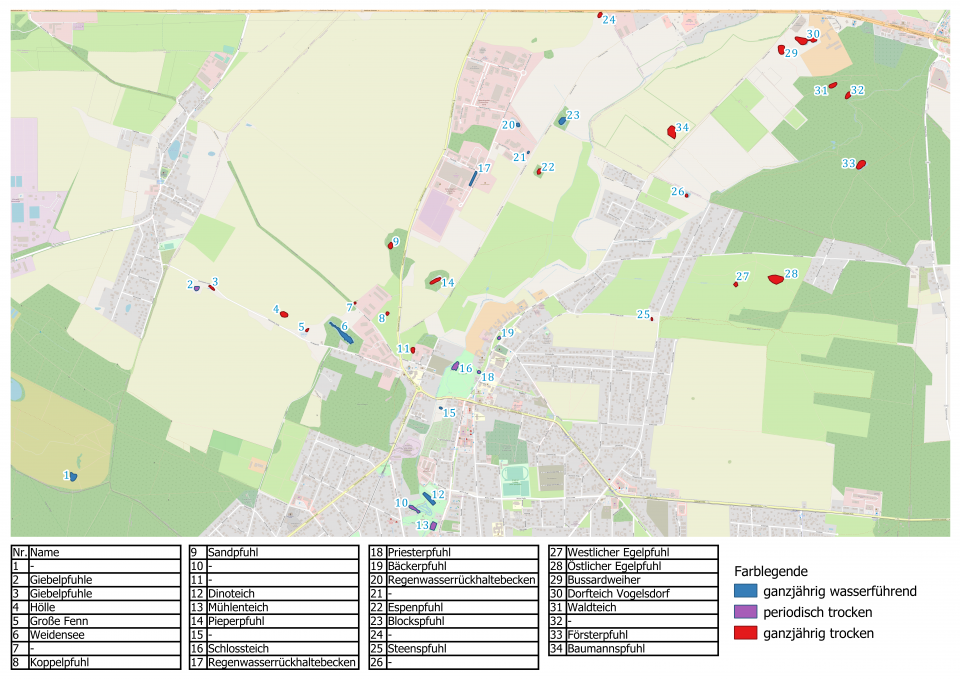
Part of the pondscape Schöneiche comprises the southern area of the Natura 2000 FFH-area „Fredersdorfer Mühlenfließ, Breites und Krummes Luch“ with the EU-Nr. 3448-302. However, while the Natura site focuses on the Fredersdorfer Mühlenfließ and its adjacent terrestrial vegetation, there is no formal protection status for the ponds of natural origin (post-glacial kettle holes) in Schöneiche, except the landscape around three ponds designed as “Natural Monument or Feature” (Flächennaturdenkmal or Geschützter Landschaftsbestandteil). The meanwhile dry ponds in the northern adjacent municipality Vogelsdorf are part of the Landschaftsschutzgebiet „Niederungssystem des Fredersdorfer Mühlenfließ und seiner Vorfluter“.
Water management: Retain water in the pondscape to prevent dry-out of ponds
Human health: A refreshing place to walk and relax, and to educate people about nature.
Biodiversity enhancement: Especially amphibians, insects, birds, and (semi)aquatic vegetation.
Water management:
- Rainwater collection from building roofs for ponds in municipality (Bäckerpfuhl, Priesterpfuhl)
- Rainwater storage ponds in Gewerbegebiet connected to Blockspfuhl for water supply
- Annual water supply to Weidensee from Fredersdorfer Mühlenfließ
- Groundwater pump to provide water to Dinoteich in Kleiner Spreewaldpark
Human health:
- Creation and maintenance of playground, paths and bridges in Kleiner Spreewaldpark
- Creation and maintenance of information boards
Biodiversity:
- Maintenance of minimum water level in some ponds to support aquatic biodiversity
- Observation of drying ponds as potential new habitat for wetland and terrestrial biodiversity
Local management approaches target the increasingly dramatic change in hydrological cycles, with negative balance between precipitation and evotranspiration, and with lower groundwater tables. This regional trend induces massive permanent loss of ponds by complete dry-out. Key actions address collected rainwater supply to ponds located in the municipality of Schöneiche, to maintain aquatic habitats.
Stakeholder awareness and engagement is facilitated by a local NGO, which contributes to participatory decision processes in the municipality. The benefits of ponds and pondscapes as Nature-based solutions are disseminated by educational formats to local school pupils and the wider public.
- Developing climate change adaptation; improving risk management and resilience
- Increase infiltration / Water storage
- Reduce drought risk
- Reducing temperature at meso or micro scale
- Developing climate change mitigation
- Restoring ecosystems and their functions
- Improve connectivity and functionality of green and blue infrastructures
- Increase Biodiversity
- Increase quality and quantity of green and blue infrastructures
- Increased cultural richness and biodiversity
- Increase accessibility to green open spaces
- Increase amount of green open spaces for residents
- Increase awareness of NBS solution & their effectiveness and co benefits
- Increase social interaction
- Increase stakeholder awareness & knowledge about NBS
- Provision of health benefits
- Social learning about location & importance of NBS
The implementation of several measures to divert rainwater or groundwater into some of the ponds prevented the complete loss of the entire pondscape. Such NbS can be easily implemented in areas with large sealed surfaces (urban or industrial sites) close to the ponds. Construction costs may be high, while maintenance costs are relatively low.
The local NGO ‘Naturschutzaktiv Schöneiche’ has developed the Kleiner Spreewaldpark as a centre for education and inspiration.Such NbS is ideally implemented in areas where natural ponds can be found even in urbanized sites.
The threats from global warming and change of landuse on water availability in the area are directly visible from the drastic annual changes of water level in Kleiner Spreewaldpark. This may motivate municipality inhabitants to engage in actions to prevent further loss of local ponds from dry-out.
Thomas Mehner (thomas.mehner@igb-berlin.de)
Further information
- 4. Quality Education
- 11. Sustainable Cities and Communities
- 13. Climate Action
- 14. Life Below Water



